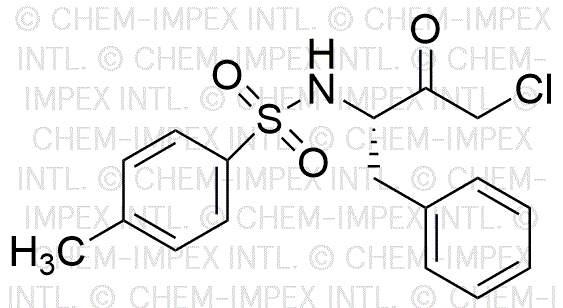Tosyl-L-Phenylalanine chloromethylketone is widely utilized in research focused on:
- Peptide Synthesis: This compound serves as a valuable reagent in the synthesis of peptides, allowing researchers to create complex structures with high specificity and efficiency.
- Enzyme Inhibition Studies: It is often used to study enzyme mechanisms by acting as a selective inhibitor, providing insights into enzyme activity and potential therapeutic targets.
- Drug Development: The compound plays a crucial role in the pharmaceutical industry for developing new drugs, particularly in designing inhibitors for various biological pathways.
- Bioconjugation: It is employed in bioconjugation processes, where it helps attach biomolecules to surfaces or other molecules, enhancing drug delivery systems and diagnostic tools.
- Research on Protein Interactions: Researchers use this chemical to investigate protein-protein interactions, which is essential for understanding cellular processes and developing new therapeutic strategies.
General Information
Properties
Safety and Regulations
Applications
Tosyl-L-Phenylalanine chloromethylketone is widely utilized in research focused on:
- Peptide Synthesis: This compound serves as a valuable reagent in the synthesis of peptides, allowing researchers to create complex structures with high specificity and efficiency.
- Enzyme Inhibition Studies: It is often used to study enzyme mechanisms by acting as a selective inhibitor, providing insights into enzyme activity and potential therapeutic targets.
- Drug Development: The compound plays a crucial role in the pharmaceutical industry for developing new drugs, particularly in designing inhibitors for various biological pathways.
- Bioconjugation: It is employed in bioconjugation processes, where it helps attach biomolecules to surfaces or other molecules, enhancing drug delivery systems and diagnostic tools.
- Research on Protein Interactions: Researchers use this chemical to investigate protein-protein interactions, which is essential for understanding cellular processes and developing new therapeutic strategies.
Documents
Safety Data Sheets (SDS)
The SDS provides comprehensive safety information on handling, storage, and disposal of the product.
Product Specification (PS)
The PS provides a comprehensive breakdown of the product’s properties, including chemical composition, physical state, purity, and storage requirements. It also details acceptable quality ranges and the product's intended applications.
Certificates of Analysis (COA)
Search for Certificates of Analysis (COA) by entering the products Lot Number. Lot and Batch Numbers can be found on a product’s label following the words ‘Lot’ or ‘Batch’.
*Catalog Number
*Lot Number
Certificates Of Origin (COO)
This COO confirms the country where the product was manufactured, and also details the materials and components used in it and whether it is derived from natural, synthetic, or other specific sources. This certificate may be required for customs, trade, and regulatory compliance.
*Catalog Number
*Lot Number
Safety Data Sheets (SDS)
The SDS provides comprehensive safety information on handling, storage, and disposal of the product.
DownloadProduct Specification (PS)
The PS provides a comprehensive breakdown of the product’s properties, including chemical composition, physical state, purity, and storage requirements. It also details acceptable quality ranges and the product's intended applications.
DownloadCertificates of Analysis (COA)
Search for Certificates of Analysis (COA) by entering the products Lot Number. Lot and Batch Numbers can be found on a product’s label following the words ‘Lot’ or ‘Batch’.
*Catalog Number
*Lot Number
Certificates Of Origin (COO)
This COO confirms the country where the product was manufactured, and also details the materials and components used in it and whether it is derived from natural, synthetic, or other specific sources. This certificate may be required for customs, trade, and regulatory compliance.


